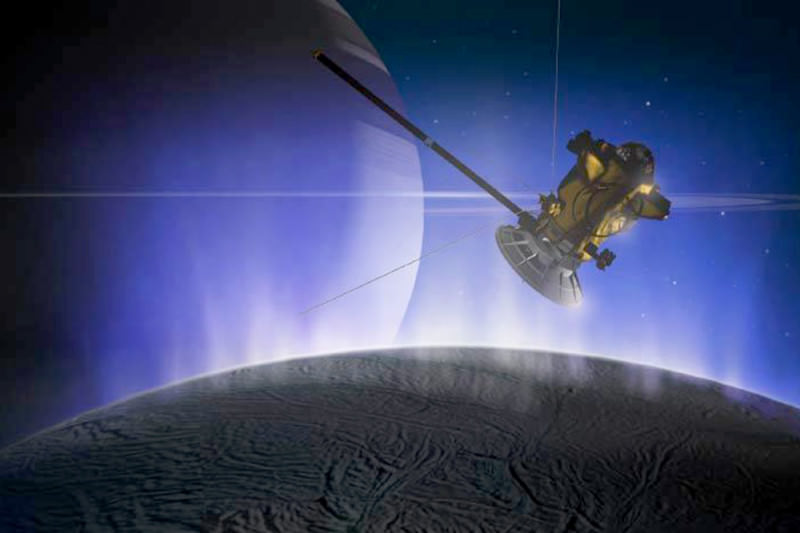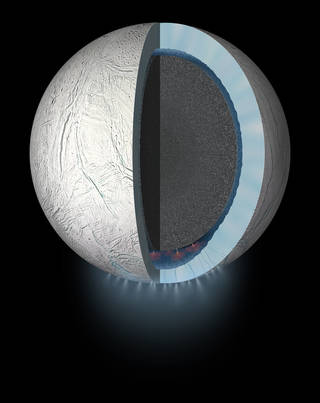We all are the descendants of the first form of life originated about 4 billion years ago o the planet Earth. Yet the complexity increases so is the study on the different life form existing and their way of origination. Science tells us that

Enceladus – Saturn’s ocean world
Five mid-sized Saturn’s moons Mimas, Enceladus, Tethys, Dione and Rhea orbit within Saturn’s E ring, beyond the main ring system. These are nearly spherical moons and have relatively low density and high albedo. The interiors of these moons are made up of water ice surrounding a small silicate core, whereas the surfaces are composed mainly of water ice.
All surfaces of moons in the E ring, except Enceladus, are dominated by impact craters and have been considered as geologically inactive for billions of years. The high albedo and relatively young un cratered geology of wide areas on Enceladus was discovered during Voyager Saturn flybys. In 2004-05 Cassini performed a number of flybys of Saturn’s icy satellites.
Clearly, the most spectacular discovery was the geological activity near Enceladus’ South Pole. An anomaly in the magnetic field near Enceladus observed by the Cassini Magnetometer in February 2005, led to a closer flyby to investigate the phenomenon. On 14 July 2005 Cassini performed a flyby of Enceladus with the closest approach of ~ 168 km from the moon’s surface. The onboard Cassini’s Imaging Science Subsystem (ISS) acquired images of Enceladus’ South Polar Terrain (SPT) and discovered jets of icy particles emitting from 135 km long fractures, situated at ~ 55°S latitude. The Composite Infrared Spectrometer (CIRS) aboard Cassini pointed out endogenic activity from SPT. The CIRS instruments detected 3 to 7 gigawatts of thermal emission from the SPT centered on the four linear stripes, the so-called “tiger stripes”.

The High Rate Detector (HRD) of the Cosmic Dust Analyzer (CDA) onboard Cassini observed a great increase in the flux of icy dust particles jettisoned from Enceladus’ the South Pole into space. The analyses made clear that many of these ice particles escape Enceladus’ gravitational influence and form the E ring. Likewise, the onboard Ion and Neutral Mass Spectrometer (INMS) detected water gas emerging from the same surface area. The onboard Ultraviolet and Imaging Spectrograph (UVIS) observed the gas plume.
A potential astrobiological candidate
The Cassini’s instruments (INMS and CDA) already provided evidence of an organic enriched Enceladian plume gas and ice grains, which indicate interesting subsurface chemistry and maybe even prebiotic chemistry.
In 2015, Cassini makes a final deep dive into Enceladus’ south polar plume and detected molecular hydrogen. In the beginning, the source of this molecular hydrogen was not clear, whether it comes from the breakup of water molecule inside the instrument or it comes directly from Enceladus’ subsurface ocean. But finally, scientists found out that molecular hydrogen, they detected, originated directly from the subsurface ocean of Enceladus.

Scientists found a large quantity of molecular hydrogen emerging from Enceladus, which is produced continuously probably from a hydrothermal vent in a similar way as it is produced in hot vents at the bottom of Earth’s ocean. In these earth’s hydrothermal vents, we know some of the earth’s oldest life forms — microorganisms exist. These microorganisms are called methanogens, which are found near hydrothermal vents without light and oxygen. These organisms convert hydrogen and carbon dioxide to methane. For them, molecular hydrogen is candy for these microbes. According to chief scientists on this project, if these earth’s methanogens transfer to Enceladus subsurface ocean, they can be survived because they would have food in the form of molecular hydrogen.
Recently a group of scientists in NASA’s jet propulsion laboratory did breakthrough research in this regard in order to propose the presence of life on other planets. Knowing the fact that the first life was formed at the hydrothermal vent. The scientists used beakers filled with a matte that were present in the primordial ocean. These resembling hydrothermal vents at the lab level acted as reservoirs for the building blocks of life. If we have these hydrothermal vents here on Earth, possibly similar reactions could occur on other planets, said JPL’s Erika Flores, co-author of the new study.
As known by the progress of science, amino acids and different organic compounds are important to form a living system. Researchers mixed water, minerals, and the amino acids precursor pyruvate and ammonia, an essential element of life. Astrobiologist Laurie Barge, the lead investigator and the first author on the new study, said Understanding how far you can go with just organics and minerals before you have an actual cell is really important for understanding what types of environments life could emerge from.

In hydrothermal vent where life formed first, the hot fluids releasing from Earth cracks interact with the Coldwater of the ocean creating a flux necessary for the life to develop and evolve. Keeping in mind the condition present there, barge and her team heated their beakers at 158°For 70°C at an alkaline pH. Since in early time the Earth was preoccupied with mineral iron hydroxide or the Green Rust than from Oxygen so the team removed oxygen from a mixture and kept the atmosphere similar for accurate results. Barge said investigating how things like the atmosphere, the ocean and the minerals in the vents all impact, this can help you understand how likely this is to have occurred on another planet.
The presence of green rust with minimal oxygen in the beakers lead to chemical reaction forming amino acid alanine and alpha hydroxy lactate. The latter is the by-product of the amino acid reaction which many scientists have theorize can form complex organic compounds that lead to life.
This research of finding ingredients of life by Barge and her team was a result of nine years ofhardwork. It was a completely new work done in this domai. The early basis on this topic was laid by JPL chemist Michael Russell who worked on whether ingredients of life are found at hydrothermal vents and what amount of energy flux is present there. Barge and her team are hoping to find more ingredients and inch her way up the chain of life. We have shown that in geological conditions similar to early Earth, and maybe to other planets, we can form amino acids and alpha hydroxy acids from a simple reaction under mild conditions that would have existed on the seafloor.
This line of research is important as scientists study worlds in our solar system and beyond that may host habitable environments. Understanding how life could start in an ocean without sunlight would assist scientists in designing future exploration missions, as well as experiments that could dig under the ice to search for evidence of amino acids or other biological molecules.
The future Mars missions could return samples from the Red Planets rusty surface, which may reveal evidence of amino acids formed by iron minerals and ancient water. We don’t have concrete evidence of life elsewhere yet,said Barge. But understanding the conditions that are required for life origin can help narrow down the places that we think life could exist


